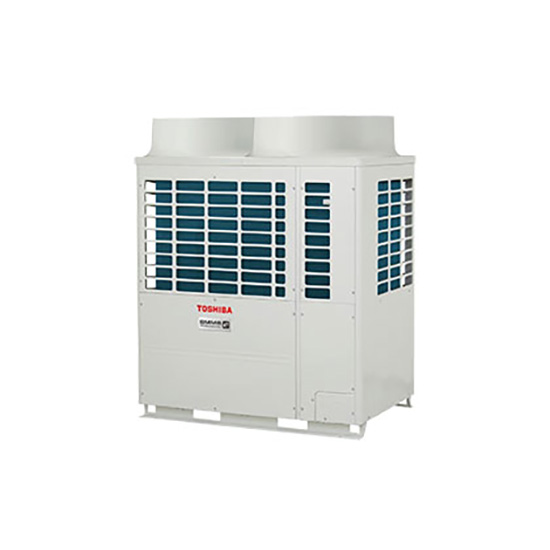Description
- Toshiba’s new VRF breaks ground for efficiency,
Continuous heating and hands-free commissioning
Toshiba Carrier is proud to announce the launch of its new SMMS-e VRF heat pump air-conditioning system, which sets a new industry standard for energy efficiency and performance.
Toshiba launched the world’s first all-inverter VRF system in 2004. The latest generation of the company’s market-leading VRF continues to push forward the boundaries, setting a new benchmark for energy efficiency, continuous heating and a revolutionary hands-free wireless commissioning and fault diagnostic system.
- Module sizes HP: 8, 10, 12, 14, 16, 18, 20 and 22
- Combination sizes: 24HP to 60HP
- Connectable indoor units: up to 64
- New DC Twin-rotary Compressor with DLC coated vane for improved capacity and energy efficiency
- New Heat Exchanger with triple layer pipe design for increased air contact with coil
- New fan design for lower noise level by up to 4 dB(A) and new 3-ph direct drive motor
- New Sub-cooling Heat Exchanger for improved energy efficiency and reliability
- New centrifugal force oil separator
- Wave interface communication tool for Smartphone (AndroidTM) commissioning and data transfer
- Space saving footprint by up to 20% when compared to previous models
- Longer piping lengths up to 1,000m
In another industry first, developments in three core technologies – the patented compressor, heat exchanger and advanced intelligent control – combine to ensure all outdoor units in Toshiba’s new SMMS-e VRF range have an ESEER (European Seasonally Adjusted Energy Efficiency Rating) higher than 7.
At its heart is a new rotary compressor, developed and manufactured by Toshiba, which uses a two-stage compression process for improved efficiency and performance. Contact surfaces on the compression vanes are treated with a high-tech Diamond-Like Carbon (DLC), giving outstanding hardness, wear resistance and reliability. It enables a significant increase in compressor rotation speed, resulting in a higher displacement volume – up to 50% greater than for the previous generation of VRF systems. This enables a higher duty to be obtained from a smaller compressor, with less power.
The compressor features the latest generation of Toshiba’s Infinity Variable Control (IVC), with the ability to adjust the compressor’s rotational speed in near seamless 0.1Hz steps. This allows the system to respond very precisely to changes in demand, to deliver outstanding comfort while minimising energy losses.
The system’s heat exchanger has been redesigned, using smaller diameter tube arranged in three rows in the coil, compared with two rows in the previous model, resulting in a 13% increase in surface area available for heat transfer, further improving performance and efficiency. The capacity of the new generation heat exchanger, previously fixed, can be adjusted to match the current load and ambient conditions. The new three-way variable heat exchanger enables the VRF’s control system to automatically select the optimum setting. In maximum, 100% of heat exchange capacity is used to deliver full cooling in high outdoor ambients. In the mid-range option, 80% of heat exchanger capacity is employed in average outdoor temperatures. And in the lowest setting, just 20% of heat exchanger capacity is used to provide gentle operation when outdoor temperatures are low. This operation ensures the coil is not flooded with excess of refrigerant, which reduces efficiency.
The SMMS-e is unique in being able to provide continuous heating, with no requirement to stop during defrosts, as with rival systems. This is made possible by the use of a new hot-gas bypass control, which simultaneously defrosts outdoor heat exchanger coils, while allowing the indoor units to ‘truly’ continue operating in heating.
On the controls front, a new approach to intelligent operation gives building occupants improved comfort and further enhances energy efficiency and reliability. SMMS-e uses Intelligent Flow Technology, based on independent Pulse Motor Valves (PMVs) to control the flow of refrigerant to each indoor unit. These deliver a carefully calibrated refrigerant flow to each indoor unit to create and then maintain optimum comfort conditions, utilising three sensors per indoor unit.
In the case of a distributed SMMS-e VRF system consisting of 64 indoor units, this means there are more than 300 individual sensors monitoring, controlling and optimising temperatures throughout the building.
For installers, Toshiba has developed Wave Tool Technology (WTT), a wireless commissioning and performance validation tool that enables engineers to read and write data to and from the condensing unit using a smart phone, without making physical contact. It enables testing and commissioning to be carried out without taking the covers off the unit, another industry first.
This is achieved using Near Field Communication (NFC) to transmit data between the outdoor unit and the engineer’s smart phone. This tool allows service and commissioning engineers to instruct and obtain key system information, simply by touching their smart phone onto the NFC tag located on the outdoor unit.
The technology simplifies commissioning and reduces the amount of time spent on-site, giving the service engineer the ability to quickly and easily send key system data via e-mail back to the office for analysis.
Importantly, the SMMS-e is available in a wider capacity range than ever before. On the smaller end of the scale, indoor units are now available in capacities of 1.7Kw (0.6hp), increasing the number of units that can be connected into a system, making it more flexible. Up the scale, outdoor units can offer up to 61.5Kw (22hp) on a single module platform, due to a newly developed chassis, this reduces footprint, pipework and speeds up installation time.
With the new SMMS-e, it is now possible to connect up to 170Kw (60hp) in a single system, with up to 64 connectable indoor units, beating the previous 135kw (48hp) maximum by a wide margin.
Improvements in pipe work and connectivity give significant advantages in terms of system design and application. Maximum total pipe work length for SMMS-e is 1000m, double the previous allowable length, with 235m now the maximum allowable distance between an outdoor unit and the farthest indoor unit, another industry first. A maximum of 40m between indoor units is enough to cover an entire 11-storey building, expanding the application envelope for Toshiba VRF to larger buildings.
Finally, as a result of the new compressors design and improved system controls, the operating temperature range has been significantly extended, and is now -5 to 46deg C for cooling operation and -25deg C to 15.5deg C in heating mode.
David Dunn, Director & general manager of Toshiba Air Conditioning, said: “SMMS-e is Toshiba’s latest and greatest VRF system to date. It embodies some important technical developments, not least on the compressor and controls front that extend efficiency and the application envelope for VRF even further into new territory.
“While end users benefit from reductions in running costs and enhanced comfort conditions, installers can take advantage of the new wireless commissioning and diagnostics system, which reduces installation time and opens up new possibilities for fast data exchange – without laying a finger on a unit. We believe the SMMS-e takes VRF technology another quantum leap forward, and is set to be a winner”





